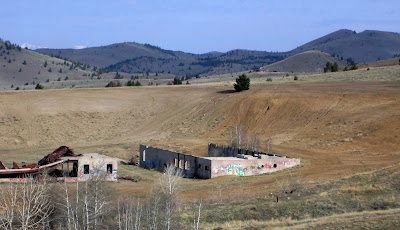So how can I be happy to see a dead little bunny on my porch? The bunny is dead, long live the bunny! After years without any wildlife on the Butte hill, a fat, lazy, old cat catching the occasional bunny is truly a sign of promise.
In 1990, when our moving van crossed over the Continental Divide and we dropped into the west-slope Silver Bow valley, my wife burst into tears. We has left the lush and green pastures of Cornell University for the trashed and toxic landscape of a burnt-over mining town. Cynics called Butte an island city surrounded by dirt. They weren't far off the mark: barren piles of mine tailings, blowing dust, kids riding motorbikes or ATVs anywhere they wanted, ... Except for the occasional grassy yard (many residents did not even bother with that artifice), the whole scence did not look far removed from the disparaging descriptions of native author Mary MacLane from the early 1900s.
Gradually, though, a recovery began. Ten years ago, when British Petroleum-ARCO first did a little superficial reclamation on nearby Missoula Gulch, the cats began bringing mice home. Then came the occasional kestrel hunting the mice. It is hard to convey my joy in seeing the cat kill a baby cottontail bunny--cruel and unfeeling, yes, but in our first ten years it was rare to see even a rabbit track around Butte. Now, they are common throughout our neighboorhood.

I've kept track of this process of recovery from the environs of my home in Walkerville, the old town on the hill above Butte.
Much of this area does not look or function environmentally any better than it did 20 years ago. Without any effort to halt the throng of off-road vehicles (mostly kids on dirt bikes and ATVs), any glimmer of recovery is steadily ground to dust. The Ryan Mine is a favorite place for the motorheads, and I suppose we will need sacrifice areas like this. There, the kids can build bonfires, party, drink, use meth, tag the walls with graffitti, and run their machines to their hearts content:

Where there are mines, there are mine dumps. What are the health consequences of these kids riding for hours on these toxic materials, and breathing all of that dust?

There is some serious gully erosion in that barren landscape:
 Knapweed, an exotic and invasive weed, seems to thrive in the abused landscape. A single plant produces many seeds, the seeds remain viable for years, the plants are phyto-toxic to competitors, and they like the dry, granitic soil. Once knapweed comes to fully dominate an area, there does not seem to be much succession. In the spring, even knapweed is tender and welcome:
Knapweed, an exotic and invasive weed, seems to thrive in the abused landscape. A single plant produces many seeds, the seeds remain viable for years, the plants are phyto-toxic to competitors, and they like the dry, granitic soil. Once knapweed comes to fully dominate an area, there does not seem to be much succession. In the spring, even knapweed is tender and welcome:
Sometimes, a fence is all it takes to promote recovery. Much of Big Butte is now fenced to exclude the motorheads:

And the children at Kennedy Elementary School have been busy (thanks to Montana Tech's CFWEP program) trying to help jump-start the recovery by planting trees and shrubs like this little pine (marked with a pink flag):

Initially I had mixed feelings when my neighbor fenced some open space behind my house. He grazes his horses there, and though they can be a little heavy on the land, he seems to be limiting their use through rest/rotation. And, with the exclusion of the off-road vehicles, I saw how both the benefits and limits of natural recovery.

In spring, life-in-recovery is especially encouraging. Snow has only recently melted, there has been rain (something we might not see at all come July and August), and tiny rosettes of native forbs perk to life (along with the knapweed at the top of the photo):

Spring flowers, too, like this little cushion plant:

And this one (in the parsley family?):

Still there are barren areas where nothing grows, and perhaps nothing will grow in my lifetime. Such as this dump--probably of coarse overburden materials:

And this pile of finer material, probably tailings (and probably more toxic):

Still, even around these dumps and tailings piles, trees get in on the act of the recovery. A decade ago, when the off road vehicles were tearing this place up, a seedling did not have a chance. Now, the lodgepole pines are growing up on the dry western slope:

And, to the north and east, where there is a little more moisture and even a few lingering spots of snow:

The Douglas firs are colonizing the area:

Butte is dead? Long live Butte!

Butte is dead? Long live Butte!

No comments:
Post a Comment